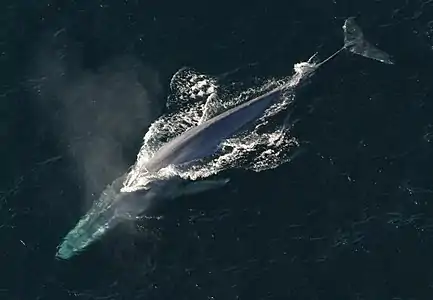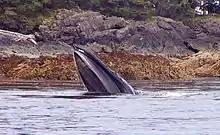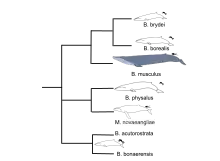Rorqual
Rorquals /ˈrɔːrkwəl/ (Balaenopteridae) are the largest group of baleen whales, a family with ten extant species in two genera. They include what is believed to be the largest animal that has ever lived, the blue whale, which can reach 180 tonnes (200 short tons), and the fin whale, which reaches 120 tonnes (130 short tons); even the smallest of the group, the northern minke whale, reaches 9 tonnes (10 short tons).
| Rorquals[1] | |
|---|---|
 | |
| Blue whale, Balaenoptera musculus | |
| Scientific classification | |
| Kingdom: | Animalia |
| Phylum: | Chordata |
| Class: | Mammalia |
| Order: | Artiodactyla |
| Infraorder: | Cetacea |
| Parvorder: | Mysticeti |
| Superfamily: | Balaenopteroidea |
| Family: | Balaenopteridae Gray 1864 |
| Genera | |
|
Balaenoptera | |
Rorquals take their name from French rorqual, which derives from the Norwegian word røyrkval, (the first element røyr originated from the Old Norse name for this type of whale, reyðr,[3] probably related to the Norse word for "red", and the second from the Norse word hvalr meaning "whale" in general).[4] The family name Balaenopteridae is from the type genus, Balaenoptera.
Characteristics
All members of the family have a series of longitudinal folds of skin running from below the mouth back to the navel (except the sei whale and common minke whale, which have shorter grooves). These furrows allow the mouth to expand immensely when feeding, "permitting them to engorge great mouthfuls of food and water in a single gulp".[5] These "pleated throat grooves" distinguish balaenopterids from other whales.[5]
Rorquals are slender and streamlined in shape, compared with their relatives the right whales, and most have narrow, elongated flippers. They have a dorsal fin, situated about two-thirds the way back. Rorquals feed by gulping in water, and then pushing it out through the baleen plates with their tongue. They feed on crustaceans, such as krill, but also on various fish, such as herrings and sardines.[6]
Gestation in rorquals lasts 11–12 months, so that both mating and birthing occur at the same time of year. Cows give birth to a single calf, which is weaned after 6–12 months, depending on species.[6] Of some species, adults live in small groups, or "pods" of two to five individuals. For example, humpback whales have a fluid social structure, often engaging behavioral practices in a pod, other times being solitary.
Distribution and habitat
Distribution is worldwide: the blue, fin, humpback, and the sei whales are found in all major oceans; the common (northern) and Antarctic (southern) minke whale species are found in all the oceans of their respective hemispheres; and either of Bryde's whale and Eden's whale occur in the Atlantic, Pacific, and Indian oceans, being absent only from the cold waters of the Arctic and Antarctic.[7] Rice's whale has the smallest distribution of rorquals and possibly baleen whales in general, being endemic to a small portion of the Gulf of Mexico west of the Florida peninsula and south of Alabama and the Florida panhandle, although it likely formerly had a much wider distribution in the Gulf.[8]
Most rorquals are strictly oceanic: the exceptions are Bryde's whale, Eden's whale, and Rice's whale (which are usually found close to shore all year round)[9] and the humpback whale (which is oceanic but passes close to shore when migrating). It is the largest and the smallest types — the blue whale and Antarctic minke whale — that occupy the coldest waters in the extreme south; the fin whale tends not to approach so close to the ice shelf; the sei whale tends to stay further north again. (In the northern hemisphere, where the continents distort weather patterns and ocean currents, these movements are less obvious, although still present.) Within each species, the largest individuals tend to approach the poles more closely, while the youngest and fittest ones tend to stay in warmer waters before leaving on their annual migration.
Most rorquals breed in tropical waters during the winter, then migrate back to the polar feeding grounds rich in plankton and krill for the short polar summer.
Feeding habits

As well as other methods, rorquals obtain prey by lunge-feeding on bait balls.[10] Lunge feeding is an extreme feeding method, where the whale accelerates to a high velocity and then opens its mouth to a large gape angle. This generates the water pressure required to expand its mouth and engulf and filter a huge amount of water and fish.[10]
Rorquals have a number of anatomical features that enable them to do this, including bilaterally separate mandibles, throat pleats that can expand to huge size, and a unique sensory organ consisting of a bundle of mechanoreceptors that helps their brains to coordinate the engulfment action.[11] Furthermore, their large nerves are flexible so that they can stretch and recoil.[12] In fact, they give rorquals the ability to open their mouths so wide that they would be capable of taking in water at volumes greater than their own sizes. These nerves are packed into a central core area that is surrounded by elastin fibers. Opening the mouth causes the nerves to unfold, and they snap back after the mouth is closed.[12] According to Potvin and Goldbogen, lunge feeding in rorquals represents the largest biomechanical event on Earth.[13]
Taxonomy

Formerly, the rorqual family Balaenopteridae was split into two subfamilies, the Balaenopterinae and the Megapterinae, with each subfamily containing one genus, Balaenoptera and Megaptera, respectively. However, the phylogeny of the various rorqual species shows the current division is paraphyletic, and in 2005, the division into subfamilies was dropped.[14] The discovery of a new species of balaenopterid, Omura's whale (Balaenoptera omurai), was announced in November 2003, which looks similar to, but smaller than, the fin whale; individuals of this species were found in Indo-Pacific waters. The discovery of the highly endangered Rice's whale was announced in 2021 after a genetic study found it to be distinct from Eden's whale; this species is known from a small portion of the northeastern Gulf of Mexico.[15]
- Family Balaenopteridae: Rorquals[16]
- †Miobalaenoptera
- †Archaebalaenoptera
- †Nehalaennia
- Balaenoptera
- Fin whale, Balaenoptera physalus
- Northern fin whale, Balaenoptera physalus physalus
- Southern fin whale, Balaenoptera physalus quoyi
- Sei whale, Balaenoptera borealis
- Bryde's whale, Balaenoptera brydei
- Eden's whale, Balaenoptera edeni
- Rice's whale, Balaenoptera ricei
- Blue whale, Balaenoptera musculus
- Pygmy blue whale, Balaenoptera musculus brevicauda
- Common minke whale, Balaenoptera acutorostrata
- Antarctic minke whale, Balaenoptera bonaerensis
- Omura's whale, Balaenoptera omurai
- Fin whale, Balaenoptera physalus
- †Cetotheriophanes
- †Diunatans
- †Incakujira
 Incakujira anilliodefuego paratype
Incakujira anilliodefuego paratype - Megaptera
- Humpback whale, Megaptera novaeangliae
- †Parabalaenoptera
- †Plesiobalaenoptera
- †Plesiocetus
- †Praemegaptera
- †Protororqualus
Alternative generic taxonomy for living rorquals
In 2012, the following alternate taxonomy was presented:[17]
- Balaenoptera
- Fin whale, Balaenoptera physalus
- Megaptera
- Humpback whale, Megaptera novaeangliae
- Pterobalaena
- Common minke whale, Pterobalaena acutorostrata
- Antarctic minke whale, Pterobalaena bonaerensis
- Rorqualus
- Sei whale, Rorqualus borealis
- Bryde's whale, Rorqualus brydei
- Eden's whale, Rorqualus edeni
- Blue whale, Rorqualus musculus
- Omura's whale, Rorqualus omurai
A 2018 genetic study suggests that gray whales (Eschrichtius robustus) be counted among the rorquals.[18]
References
Notes
- Mead, J.G.; Brownell, R. L. Jr. (2005). "Order Cetacea". In Wilson, D.E.; Reeder, D.M (eds.). Mammal Species of the World: A Taxonomic and Geographic Reference (3rd ed.). Johns Hopkins University Press. pp. 723–743. ISBN 978-0-8018-8221-0. OCLC 62265494.
- "Family Balaenopteridae Gray 1864 (rorqual)". Fossilworks. Retrieved 9 April 2018.
- "rorqual". Oxford English Dictionary (Online ed.). Oxford University Press. (Subscription or participating institution membership required.): "ad. Norw. røyrkval, repr. ON. *røyðar-, OIcel. reyðar-hvalr, f. reyðurreyðr the specific name + hvalr whale."
- The Century Dictionary. 1895. p. 5228.
- Minasian, Stanley M.; Balcomb, Kenneth C.; Foster, Larry, eds. (1984). The World's Whales: The Complete Illustrated Guide. New York: The Smithsonian Institution. p. 18. ISBN 978-0-89599-014-3.
- Gambell, Ray (1984). Macdonald, D (ed.). The Encyclopedia of Mammals. New York: Facts on File. pp. 222–225. ISBN 978-0-87196-871-5.
- "All About Baleen Whales | SeaWorld Parks & Entertainment". seaworld.org. Retrieved 2021-01-23.
- Rosel, Patricia E.; Wilcox, Lynsey A.; Yamada, Tadasu K.; Mullin, Keith D. "A new species of baleen whale (Balaenoptera) from the Gulf of Mexico, with a review of its geographic distribution". Marine Mammal Science. n/a (n/a). doi:10.1111/mms.12776. ISSN 1748-7692.
- Handbook, Whale Watching (2021-01-22). "Bryde's Whale". Whale Watching Handbook. Retrieved 2021-01-23.
- Reeves, RR; Stewart, BS; Clapham, PJ; Powell, JA (2002). National Audubon Society Guide to Marine Mammals of the World. Chanticleer Press. ISBN 978-0-375-41141-0.
- Pyenson, N.D.; Goldbogen, J.A.; Vogl, A.W.; Szathmary, G; Drake, R.L.; Shadwick, R.E. (2012). "Discovery of a sensory organ that coordinates lunge feeding in rorqual whales". Nature. Nature Publishing Group. 485 (7399): 498–501. Bibcode:2012Natur.485..498P. doi:10.1038/nature11135. PMID 22622577. S2CID 1200222.
- McSpadden, Kevin (5 May 2015). "Gigantic Whales Eat Thanks To 'Bungee-Cord' Nerves". TIME.com. Retrieved 6 May 2015.
- Potvin, J; Goldbogen, J.A. (2009). "Passive versus active engulfment: verdict from trajectory simulations of lunge-feeding fin whales Balaenoptera physalus". J. R. Soc. Interface. 6 (40): 1005–1025. doi:10.1098/rsif.2008.0492. PMC 2827442. PMID 19158011.
- Deméré, T.A.; Berta, A.; McGowen, M.R. (2005). "The taxonomic and evolutionary history of fossil and modern balaenopteroid mysticetes". Journal of Mammalian Evolution. 12 (1/2): 99–143. doi:10.1007/s10914-005-6944-3. S2CID 90231.
- Fisheries, NOAA (2021-01-19). "Gulf of Mexico Bryde's Whale | NOAA Fisheries". NOAA. Retrieved 2021-01-22.
- Thalassotherii in the Paleobiology Database. Retrieved October 2013.
- Hassanin, A.; Delsuc, F.; Rpiquet, A.; Hammer, C.; Vuuren, B. J.; Matthee, C.; Ruiz-Garcia, M.; Gatzeflis, F.; Areskoug, V.; Nguyen, T. T.; Couloux, A. (2012). "Pattern and timing of diversification of Cetartiodactyla (Mammalia, Laurasiatheria), as revealed by a comprehensive analysis of mitochondrial genomes". Comptes Rendus Biologies. 335 (1): 32–50. doi:10.1016/j.crvi.2011.11.002. PMID 22226162.
- Árnason, Úlfur; Lammers, Fritjof; Kumar, Vikas; Nilsson, Maria A.; Janke, Axel (2018). "Whole-genome sequencing of the blue whale and other rorquals finds signatures for introgressive gene flow". Science Advances. 4 (4): eaap9873. Bibcode:2018SciA....4.9873A. doi:10.1126/sciadv.aap9873. PMC 5884691. PMID 29632892.
Sources
- Gray, J. E. (1864). "Notes on the Whalebone-Whales; with a Synopsis of the Species". The Annals and Magazine of Natural History. 14 (83): 345–353. doi:10.1080/00222936408681724. Lay summary (October 2013).
External links
 Media related to Balaenopteridae at Wikimedia Commons
Media related to Balaenopteridae at Wikimedia Commons Data related to Balaenopteridae at Wikispecies
Data related to Balaenopteridae at Wikispecies- . Encyclopædia Britannica (11th ed.). 1911.
